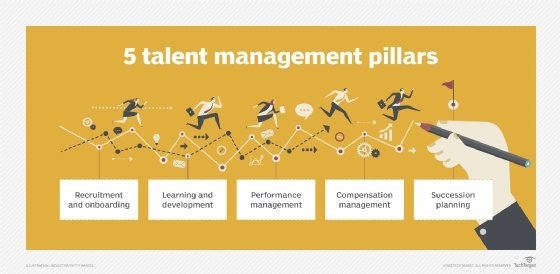talent management software (TM software)
What is talent management software (TM software)?
Talent management software is technology that human resource management professionals use to manage employees as a competitive advantage. Talent management can refer to a standalone application from a niche vendor that specifically addresses one part of the process, such as a learning management system. Or the HR technology can be an integrated suite of software applications aimed at the entire employee lifecycle.
In the latter sense, talent management software is often referred to as a talent management system and automates certain processes from the time potential employees apply to when they are hired until they retire. Talent management systems typically contain applications that fall into the broad functional areas, referred to as pillars. Cloud-based talent management software has become the prevailing norm.
Pillars of talent management
Traditionally, there were four pillars -- or modules -- of talent management applications, but a number of experts and vendors refer to five pillars of talent management. Regardless of the number and names, talent management systems include applications that fall into one of these following broad functional areas. The names and number of pillars change depending on the talent management systems vendor, but the concepts remain the same:
- Recruitment and onboarding.
- Learning and development.
- Performance management.
- Compensation management.
- Succession planning.

Recruitment and onboarding software
Recruiting and onboarding focus on attracting and hiring the best employees and successfully integrating them into the organization. Successfully recruiting and onboarding employees require creating the best impressions of the organization, first from the outside as a potential candidate, then from the inside as a new hire. Both are highly influential on an employee's tenure at the organization, and software is critical for many companies to support all stages in the process. An application tracking system is typically a part of recruitment.
Learning and development software
Learning and development includes all the areas that relate to developing and training employees, including compliance training, and workforce and career development. By providing career growth and training opportunities, organizations can boost employee satisfaction and retention, as well as become more efficient and productive.
Performance management software
Performance management includes goal setting for the company and for the various teams and employees. As it relates to employees, performance management focuses on measuring, appraising and managing employee performance. With its concrete goal-setting and measurement, performance management helps companies better understand how well they're doing in various categories.
Performance management also enables managers to identify top performers and evaluate employees over time. Continuous performance management tools have become popular because they provide more timely feedback and have a number of other benefits. Organizations use these tools to foster growth and performance either in addition to traditional annual reviews or as a replacement for them.
Compensation management software
Compensation management provides financial value to employees and can include salary, bonuses and benefits packages. Compensation management software can help acquire and retain the talent by rewarding employees fairly and competitively. The software can boost employee retention by rewarding success with pay-for-performance compensation management and help prevent employee frustration for a lack of recognition.
Succession planning software
Succession planning is focused on identifying successors for key position or roles. Succession planning software helps ensure that each area of the company has a pool of employees available for various roles.
Talent management software history
Talent management systems became popular around 2000, after McKinsey & Company published a study, "The War for Talent," in 1998. The authors used the term talent management and popularized a new view of employees as a competitive advantage, which in turn inspired software vendors to create integrated systems that could help manage their employees in this way. Previously, performance management and training tools had existed in rudimentary forms that supported the basics of these processes.
Today, cloud technology is a standard choice, with HR and talent management software-as-a-service vendors in the market.
Talent management systems vs. core HCM
Some talent management software vendors have grown into the human capital management (HCM) market by packaging core HCM functions with their talent management products as an end-to-end HCM suite. This pairing enables companies to use HCM as a supportive foundation for talent processes with the added advantage of having a single system for all HR processes. Some talent management system vendors have offered some version of core HR from the start.
An HCM that enables integration with talent management applications likely includes these key features: a dashboard featuring notifications; workflows from all modules; company and departmental communications; employee profile and personnel files; employee and manager self-service functions. HCM suites may also have document tracking and automated updates when organizational changes are made.
See also: human resource management system (HRMS), human resource information system (HRIS)






